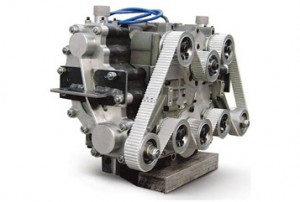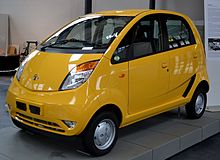TATA Nano,world’s cheapest car
It seems like every few months, we get wind of another vehicle that is supposed to be powered by compressed air. The Mini Cat Air Car, from India-based Tata Motors, seems almost too good to be true. Tata Motors is India’s largest automobile company. It is the leader in commercial vehicles, and among the top three in passenger vehicles.
Designed by an ex-IndyCar™ engineer, the Mini Cat utilizes compressed air to move its motors’ pistons, claims zero tailpipe emissions, and an extremely low cost to run. Is it the real deal, or a lot of hot air?
Compressed-air has been used to power a wide variety of vehicles since the 1800s with only limited success, due to inherent inefficiencies. The concept found some limited success in powering locomotives, mostly used for mining, where a combustion-free energy source was desirable. Ultimately, even these were replaced by more efficient electric motors.
Several modern companies have attempted to produce a working compressed-air powered car, but none have yet to reach the consumer market.
Energine Corporation, of Korea, claimed that it was going to deliver a hybrid compressed-air/electric car, only to see its CEO arrested for making exaggerated claims.
K’Airmobiles, a French company, were another compressed air concept, but it never saw the light of day. The company was unable to procure the necessary funding, and the engineers who worked on the project, ultimately admitted that the inherent efficiency and low-running-temperature problems made the project unfeasible.
In 2010, Honda showed off the Honda Air concept car, a 1,000-pound, 4-passenger car, made out of composite materials. (While the concept sounds good, in theory, I would hazard a guess that the high price of the composite materials used in this car would make it unable to compete with other alternatively-fueld vehicles.)

The TaTa Air Car concept engine was developed by Motor Development International (“MDI”), of France, with the backing of Tata. (This version of a compressed air engine has been in development for over 20 years.) Zero Pollution Motors holds a license to produce the cars in the U.S. market.
However, this version of an air-powered car has also been beset with problems.
In 2008, Popular Mechanics wrote, “Zero Pollution Motors confirmed to PopularMechanics.com on Thursday that it expects to produce the world’s first air-powered car for the United States by late 2009 or early 2010.”
Although there are several blogs, and news outlets, which still refer to Zero Pollution Motors as the holder of the U.S. license to produce MDI’s Air Cars, I was unable to uncover any evidence that the company is still in existence, at least in any substantial form. (For example, the company’s website, zeropollutionmotors.us, has a suspended domain name.)
In 2009, Tata Motors’ vice-president (engineering systems) S. Ravishankar told DNA Money the project is facing difficulties in terms of vehicle range and cooling. Ravishankar said, “Air is not a fuel, it is just an energy carrier. So a tank full of air does not have the same energy as a tank full of CNG. Any vehicle using only compressed air to run would face problems of range.”
The article continues: “Ravishankar…went on to say that excessively low engine temperature is another problem, in a vehicle using only compressed gas as fuel.”
In April of this year, InAutoNews.com explained that the cars, intended for the U.S. market, would not be entirely emissions-free, because a small gasoline engine was required, to allow the car to run at city speeds. (Perhaps this was the reason, for the long delay, in bringing the air car to market? Perhaps the designers were attempting to figure out a way to make the One Cat run on compressed air, only?)
In December of 2009, UC Berkeley, ICF International and Stanford experts had this to say about the feasibility of compressed air versus chemical fuels, as an energy storage medium: “The study concluded that even under highly optimistic assumptions the compressed air car is less efficient than a battery electric vehicle and produces more greenhouse gas emissions than a conventional gas powered car with a coal intensive power mix. It did state however, that a pneumatic combustion hybrid is feasible and inexpensive and could compete with hybrid electric vehicles.

The 2nd generation Tata Indica V2’s fuel economy, powerful engine and aggressive marketing strategy made it one of the best selling cars in the history of the Indian automobile industry
So, it would appear that the jury is not entirely out on the feasibility of a compressed air powered car, but it certainly does not look good for the Tata/MDI version.
But let’s assume that the Mini Cat Air Car really does live up to the claims of the manufacturer. Just how environmentally-friendly is a compressed air car, anyway?
In 2009, that’s exactly what Popular Mechanics endeavored to find out. They compared the Zero Pollution Motors AirPod (an extremely strange-looking precursor to the Mini Cat), to electric, gas, hybrid and diesel. The numbers include the CO2 produced, by the generation of any required electricity. The results were interesting:
- Zero Pollution Motors AirPod: “24.014 pounds CO2 for 100 miles”
- Tesla Roadster: “32.98 pounds of CO2 for 100 miles”
- 2010 Toyota Prius: “39.192 pound of CO2 for 100 miles”
- 2009 Honda Civic (non-hybrid): “64.67 pounds of CO2 for 100 miles”
- 2009 VW Jetta TDI Diesel: “62.5 pound of CO2 for 100 miles”
So, from a strictly empirical analysis, it would appear that air cars (if they were feasible) would have a bit of an edge where pollution is concerned. Of course, air cars would still not have the speeds necessary to allow them to be driven on highways.
Being an eternal optimist, I still hold out hope that Tata isn’t just “blowing smoke.” I’m not going to hold my breath, though.

Steve Puma
September 4th, 2011
Steve Puma is Director of Business Development for SABA Motors, and a sustainability writer/consultant. His work focuses (mostly) on clean transportation, including Plug-In Electric Vehicles, something he is very passionate about.
Steve holds an MBA in Sustainable Management from Presidio Graduate School and a BA in Computer Science from Rutgers University. You can learn more about Steve by reading his blog, or following his tweets.










































